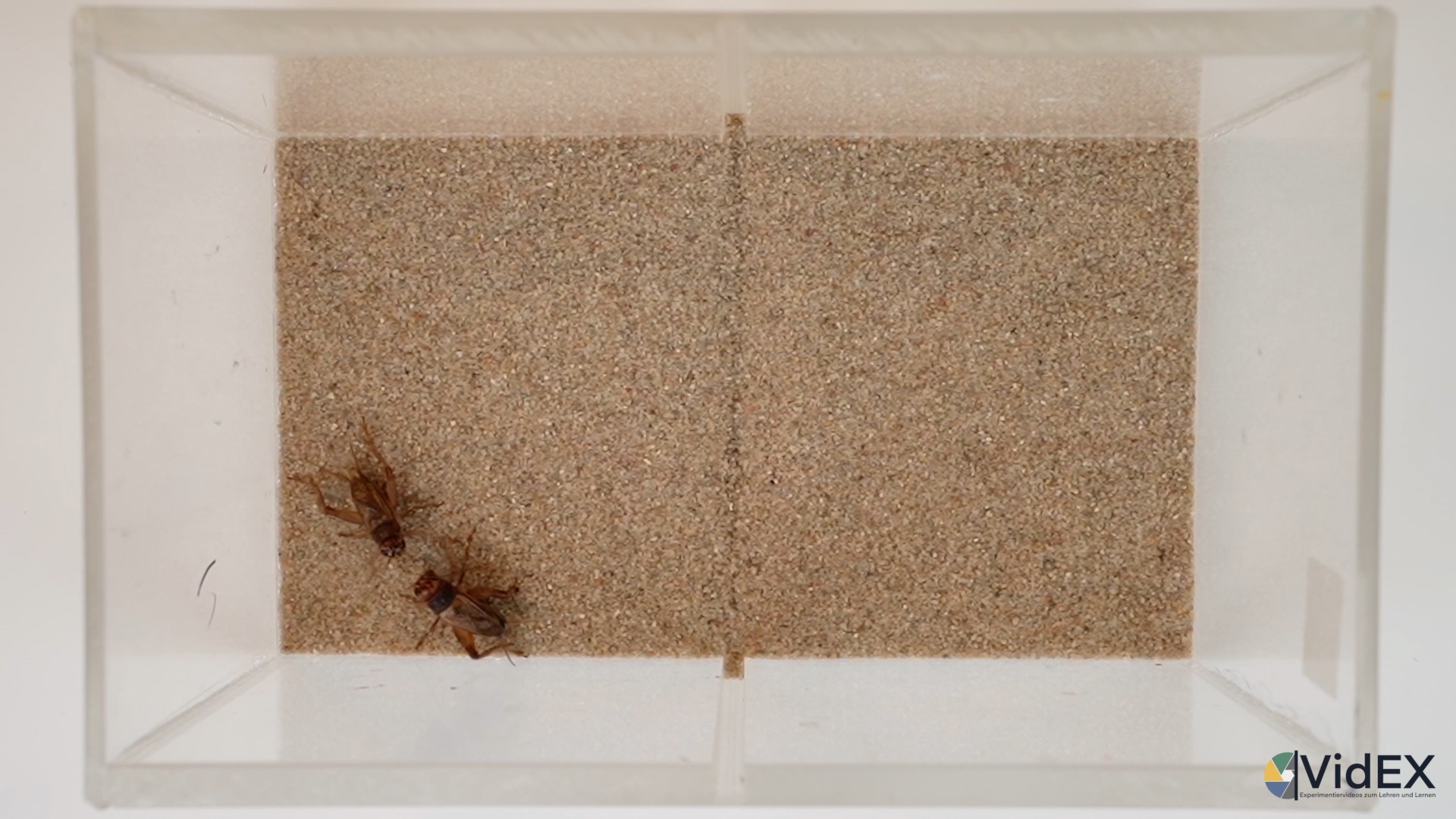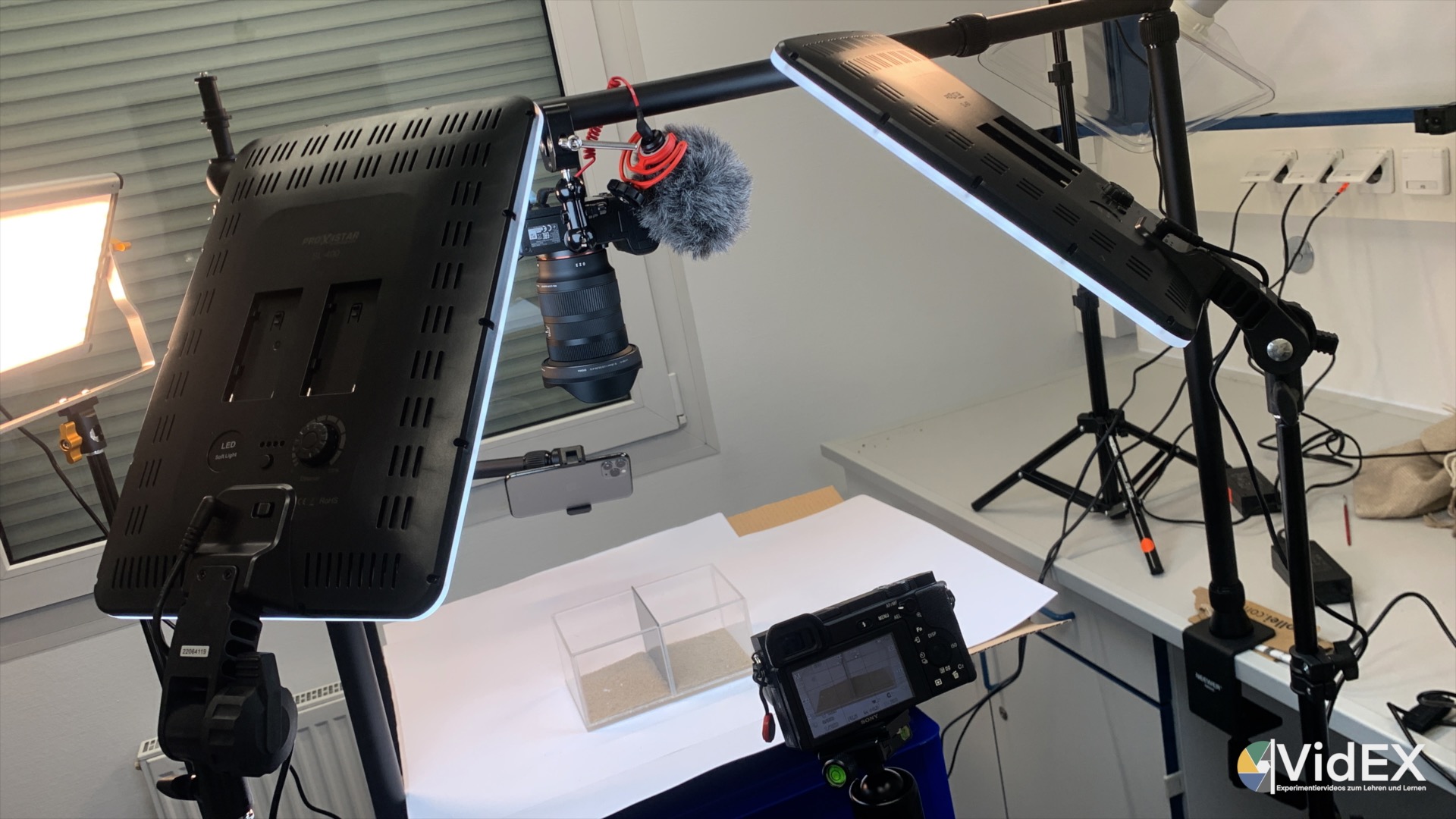




Intra-species communication in the animal kingdom can take place in many different ways and fulfil various functions. The typical chirping of crickets depends on the situation and serves both to attract females and to ward off other males. In this module, students are given the opportunity to observe intra-species communication. To do this, they can closely observe various cricket behaviours and songs, record data and process it in order to draw conclusions about the biological benefits of cricket behaviour and songs.
Translated with DeepL.com (free version)
Known as a food animal for various terrarium animals or from a walk in the meadow – the crickets!
Image with audio track from VidEX, 2024. CC BY-NC 4.0
Everyone has probably heard the chirping of crickets. However, there is not just one cricket song, as male crickets produce three different songs depending on the situation. The latter are associated with behaviour typical of the species, such as aggressive behaviour during territorial fights. As inconspicuous as these animals may be, the observation and interpretation of aggressive behaviour in particular provides a variety of thematic references for a “lively” biology lesson. As an introduction, the familiar chirping of crickets from everyday life can be taken up and a walk across the meadow in the classroom can be simulated using an audio recording: Which animals can be heard here? What is already known about them? How do the animals behave in their habitat? What social behaviour do they display?
In this module, the aggressive behaviour and songs as well as other behaviours can be observed in the group of crickets (Gryllus assimilis).
Note: The crickets are not usually injured during the fights. The aggressive behaviour is typical of the species.
For the cricket fight videos 1 to 3, it is a good idea to work in teams of two learners. The learners can focus on one animal at a time and follow it during the fight. In video 4, the number of learners should be increased according to the number of crickets to be observed. It is not absolutely necessary to observe 1-to-1, but it is also not advisable to observe more than two animals at the same time.
Video 1 and 3 can also be used in a differentiated manner in the classroom in terms of the time and scope of data collection/processing.
The videos are suitable for use in both the intermediate and advanced levels. Depending on the class level, the following research questions can be used to focus on intraspecific competition following the observations: Why do male crickets fight in the first place? What biological benefit could it have that these behaviour patterns have developed in crickets during evolution? With regard to the winner and loser fight, the physiological background of the winner and loser effect can be discussed.
Video 1 & 3: Before observing the aggressive behaviour, the learners can formulate hypotheses based on the pictures and weight information about the crickets as to whether a fight will take place and, if so, who will emerge victorious.
Video 2: Hypotheses can be formulated to explain the fight behaviour that is NOT observed or the avoidance of a fight. This is also possible with video 1 on the outcome in the 2nd round.
Material to form hypothesis:
Video 1 download
Video 3 download
Before watching the videos, it is advisable to have the learners work out the behaviour of the crickets at the respective combat levels or to discuss their appearance with the learners. It is also helpful to include tips in the video observation, such as
… individually stopping and watching important scenes several times.
… the slow, individually controlled running of relevant scenes (i.e. manual slow motion to better recognise the fight levels).
… the distribution of crickets among the observers in the team.
Video 1 & 3: The observation data can be documented in tabular form for each cricket at a defined time interval or when the behaviour occurs. In addition to a qualitative description of the behaviour, an assignment to the respective fight levels is made depending on the observed behaviour. The duration and characteristics of the fight levels are documented.
Video 4: The learners can analyse the chants and work out the differences. Here it is advisable for the learners to document the characteristics of the chant, the associated behavioural context and the addressee in a table. The specific function of the respective song should then be discussed. In addition, fights and aggressive behaviour can also be observed in this video, which can be recorded and processed in the same way as in videos 1 and 3. It may be a good idea to initially divide the observation of the chants and the fights between the learners in order to then combine the findings in the evaluation phase. To do this, an observation and measurement concept with fixed time intervals and characteristics to be observed must be agreed together.
Note on video 4: The fauna box contains an animal that has died of old age. This animal did not die during the recording or in the fight. A number of behaviours can be observed around this deceased animal, which serves as a food source for its conspecifics.
The video material “Behaviour & song of crickets”
Here you can download the material associated with the module, such as a picture with all the necessary materials and pictures of different cricket species. You can also download a background paper on the behaviour of crickets.
Authors of this module: This VidEX module was developed and produced in close collaboration with Marius Schumann and Dr Michael Weidhase from the Landesgymnasium St. Afra in Meißen. They provided the content basis with their concept for the “Cricket Lab“, which was selected for the next round of the European Science on Stage 2024 at the Science on Stage Festival 2023 in Bayreuth.
Note: This article is only available in german language!